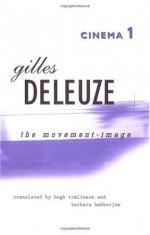|
This section contains 434 words (approx. 2 pages at 400 words per page) |

|
Cinema 1: The Movement-Image Summary & Study Guide Description
Cinema 1: The Movement-Image Summary & Study Guide includes comprehensive information and analysis to help you understand the book. This study guide contains the following sections:
This detailed literature summary also contains Topics for Discussion and a Free Quiz on Cinema 1: The Movement-Image by Gilles Deleuze.
In his first book about film, Gilles Deleuze writes about the traditional meaning of the word "philosophy" as "the creation of concepts." This book, titled "Cinema 1", is published in 1983, in which he proposes, ". . . it is not sufficient to compare the great directors of the cinema with painters, architects or even musicians. They must also be compared with thinkers. . . . that the future makes possible."
Deleuze presents philosophical concepts that are the images of thought and "exactly like sounds, colours or images, they are intensities which either suit you or don't, which work or don't." Deleuze creates concepts alongside cinema. His translators, Tomlinson and Habberjam, claim this book intercuts cinema and philosophy to bring together ideas from each sphere. Deleuze starts by critiquing Henri Bergson's theses and goes on to critique Peirce's classification of sign types in an approach to images. Readers can benefit from prior study, knowledge and understanding of classical philosophy and phenomenology.
This is a challenging study of the nexus where cinema and philosophy meet. "Cinema 1" is not about the movies, nor about philosophy, but rather about both. The tone of this work is objective, structured, logical and analytic. Ironically, despite the generally high emotive content of cinema, this text is unemotional and devoid of the creative fantasy found in moving pictures. This academic study is researched and annotated. "Cinema 1" will impress the reader with its sophistication and far-reaching breadth of study for as long as the reader remains alert. The effect on a casual reader is challenging and strenuous but unemotional, not stimulating and clearly not a "page-turner."
"Cinema 1, The Movement Image" written by Gilles Deleuze is a 250 page text with detailed Contents, Preface and Translator's introduction. The body is comprised of twelve numbered chapters with titles describing subject matter of the chapter. Each chapter is detailed in three numbered subsections with subheadings that indicate the subsection subject matter that is unabridged in the Contents. For example, the Contents page shows Chapter 3, "Montage" but then details subsection 1, with: "The third level: the whole, the composition of movement images and the indirect image of time / the American school: organic composition and montage in Griffith / the two aspects of time: the interval and the whole, the variable present and immensity." Back matter of the text includes Glossary, Notes and an Index. The Index lists directors, films, characters and ideas referenced by page number which is essential to the casual reader's ability to find a way through the confusing verbiage of this philosophical work. Deleuze uses a format to make "Cinema 1" a highly structured and researched philosophical study of the cinema.
Read more from the Study Guide
|
This section contains 434 words (approx. 2 pages at 400 words per page) |

|



